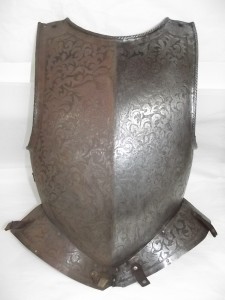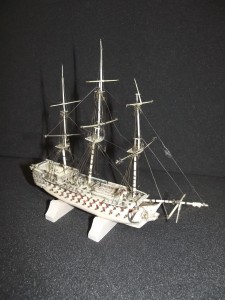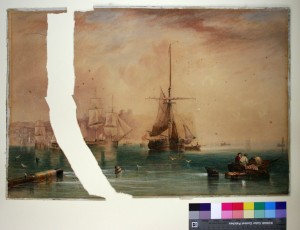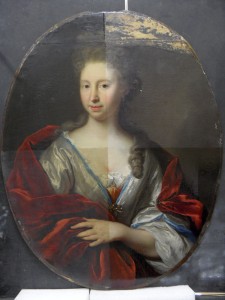The conservation department have got together to show a sample of some of the work that we do in the studios across the venues several objects were conserved or part conserved for an exhibition which is on display on the grond floor in the Hub area of Discovery Museum.

Breast plate from a suit of armour possibly dating back to the 15th century. The breast plate is decorated with a floral pattern like the “mantling”, or drapery, of a coat of arms. The decorative design is completed by a knight in a full suit of armour and a mythical phoenix.
The breast plate was covered in a heavy layer of red iron corrosion which was disfiguring the surface of the armour and if left could have led to extensive damage.
For the purpose of this display the corrosion has been removed from one half of the breast plate, and it has been left in place on the other half in order to highlight the difference. The corrosion will be completely removed from the breast plate when the armour is removed from this display.
There are a range of objects from the different conservation departments to raise awareness of what we do behind the scenes.
We have recently started to offer our services to the public so if you have a treasured object that has seen better days get in contact and we will see if there is anything we can do for you. Below is a sample of some of the stuff on display

This model of a Man o’ War has been crafted from animal bone by a Napoleonic prisoner of war. The prisoners made objects from bone, straw and wood which were easy to find, in order to produce high quality objects such as woven straw boxes and models of ships and guillotines.
“Man o’ War” was a Royal Navy term from the age of sail for a powerful warship which had many cannons. This model represents one of the largest of these with 104 guns on three decks, although it is not modelled on any particular ship.
The model was very badly damaged; the masts had broken and had detached from the model, and much of the rigging was broken and tangled. The masts have been put back into position using a two-part adhesive, and the rigging has been repaired and replaced, but only where it has been possible to identify where the original rigging would have been.

Watercolour painting on paper, attributed to James Wilson Carmichael (1800 – 1868)
Carmichael was born in Newcastle. He completed his apprenticeship as a ship’s carpenter, but devoted much of his free time to art and was eventually able to make a living as a painter. He is well known as a marine artist.
Residues of paper and animal glue at the edges of the painting show that it was once attached to a window mount and backing board. The brown line of discolouration just inside the edge is a result of contact with acidic mount board. Contact with poor quality materials, and unsuitable environmental conditions have caused the paper to become discoloured and brittle. It has lost flexibility, resulting in cracking and tearing at the left side.
Dark brown spots in the image are known as ‘fox marks’ and can occur when small, impurities in the paper become degraded.
Conservation Treatment
The painting has been treated to reduce discolouration and remove acidity from the paper. Cracked and torn areas have been repaired at the back using good quality materials that can be easily removed if necessary. Small areas of loss along the tear have been filled and carefully retouched so that they no longer distract the eye from the image.
For display, the painting has been hinged into a window mount. The mount is made from high quality, acid free materials and contains an alkaline buffer to protect the painting from future acid attack. The bevelled window also serves to prevent contact with the glass if the painting is framed.

The Painting
This high quality portrait came into the Hatton collection when it was part of Durham University. There is very little information about it apart from it was partially restored by Helmut Ruhemann in 1960.
Condition
This oil painting is on a canvas covered panel. Marks around the outer edge of the painting (known as stretcher bar mark) lead to the conclusion that it was originally a stretched canvas and has been mounted onto the panel at a later date. The panel is attached to the vertical planks, but the top horizontal plank has shrunk and ripped the canvas. Old fills and retouching in this area are evidence of older damage. There is a second rip in the canvas (centre right) and paint loss to the right of her hair. The paint is cracked with age and lifting slightly around the edges of the cracks. The surface of the painting was covered with a thick layer of dirt on top of a yellowed varnish with drip marks running horizontally across the face.
Treatment
The bottom left section has had the thick dirt layer left in place for display purposes. In the top left section the yellow and discoloured varnish has been left in place. The top right section has had the varnish and old retouching’s removed, damages consolidated, and filled ready for retouching. The bottom right section has been fully conserved, retouched and varnish to a display standard
The Frame
Condition
This hand carved and gilded frame is typical of an 16th C frame and was very damaged. The wooden joints had split with chunks missing from the inner edge. The gesso and gilding were missing or flaking in many areas and the surface dirt was so thick that the gold appeared to be discoloured bronze paint until cleaning tests revealed the 24ct gold underneath.
Treatment
The frame has been glued back together. In the bottom left section the frame has been untouched, with the thick layer of dirt and flaking finish. In the top left section the dirt has been removed to reveal the damaged gilding and gesso. In the top right section the gesso and gilding has been consolidated and filled for re-gilding. The bottom right section has been re-gilded and then toned to match the original gilding.
2 Responses to Conservation on Display